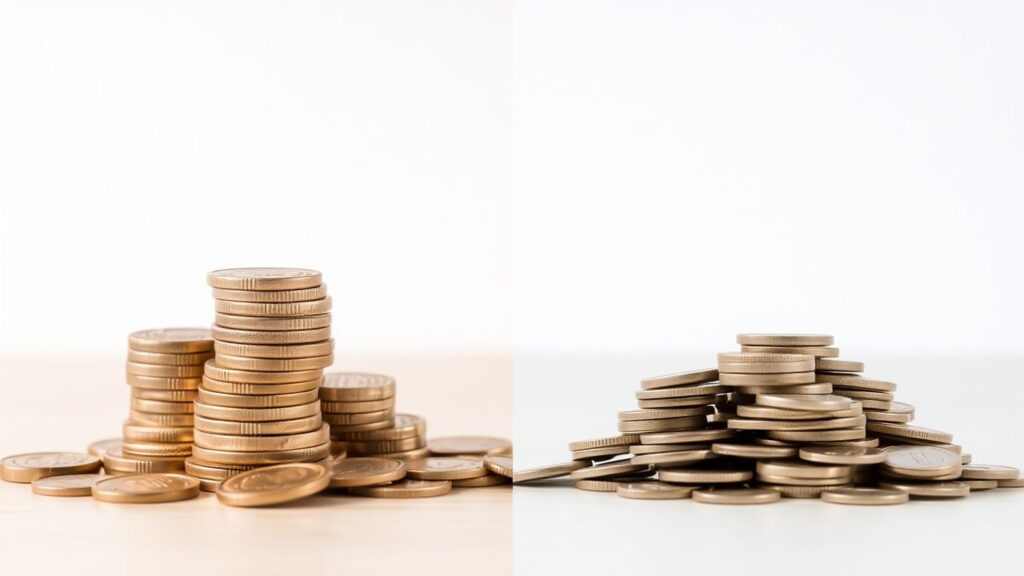
Ever feel like your money is just sitting there, not really doing much? Well, there’s a way to make it work harder for you, and it’s called compound interest. It’s not some fancy financial wizardry; it’s a pretty straightforward concept that can make a big difference in your savings and investments over time. Think of it as your money having babies, and then those babies having babies. We’ll break down what compound interest is, how it actually works, and why it’s a big deal, especially when it comes to your investments.
Key Takeaways
- Compound interest means you earn interest not just on your initial money, but also on the interest you’ve already earned – it’s like getting paid interest on your interest.
- This ‘interest on interest’ effect helps your savings or investments grow much faster than if you only earned simple interest.
- The Rule of 72 is a quick way to guess how long it might take for your money to double: just divide 72 by the interest rate.
- Interest can be calculated and added back to your balance at different times, like daily, monthly, or yearly. The more often this happens, the faster your money can grow.
- Starting early with compound interest for your investments gives your money more time to grow, leading to a much larger amount down the road.
Understanding Compound Interest

What Compound Interest Means
So, what exactly is compound interest? At its heart, it’s a way your money can grow where you earn interest not just on your initial deposit, but also on the interest that has already been added to your account. Think of it like a snowball rolling down a hill. It starts small, but as it rolls, it picks up more snow, getting bigger and bigger at an accelerating pace. This “interest on interest” effect is what makes compound interest so powerful for growing your savings over time. It’s a concept that applies to savings accounts, investments, and even loans, though in the case of loans, it means your debt can grow much faster.
The Core Principle of Earning Interest on Interest
The main idea behind compound interest is pretty straightforward: your earnings start earning money too. Let’s break it down:
- Initial Deposit: You put some money into an account.
- First Interest Calculation: You earn interest on that initial amount.
- Compounding: That earned interest gets added to your original deposit.
- Next Interest Calculation: Now, you earn interest on the new, larger total (your original deposit plus the first bit of interest).
This cycle repeats, meaning your money grows at an increasing rate. It’s a key reason why starting to save early can make such a big difference in the long run. The longer your money has to compound, the more significant the growth becomes. This is a core concept in personal finance.
Compound Interest in Investments
When we talk about investments, compound interest is often the engine driving wealth accumulation. Whether you’re looking at stocks, bonds, mutual funds, or even certificates of deposit (CDs), the earnings generated can be reinvested. This reinvestment is what allows compounding to work its magic. Instead of taking out the dividends or interest earned, letting them sit in the investment account means they become part of the principal that earns future returns. This process can significantly boost your investment portfolio’s value over many years, far beyond what simple interest could achieve. It’s a patient person’s game, but the rewards can be substantial.
How Compound Interest Works
So, how does this magic of earning interest on your interest actually happen? It’s not really magic, but it sure feels like it when you see your money grow faster over time. The core idea is that your earnings from interest get added back into your original amount, and then the next time interest is calculated, it’s based on that new, bigger total.
The Mechanics of Compounding
Think of it like a snowball rolling down a hill. It starts small, but as it rolls, it picks up more snow, getting bigger and bigger. Compound interest works similarly. You start with an initial amount, let’s call it the principal. You earn interest on that principal. Then, that interest gets added to the principal. The next time interest is calculated, it’s on the original principal plus the interest you already earned. This cycle repeats, and the growth accelerates because your interest base keeps expanding.
Calculating Compound Interest
While it sounds complicated, there’s a formula to figure out exactly how much your money will grow. You don’t need to be a math whiz, though, as many online calculators can do the heavy lifting for you. The basic idea involves your principal amount (P), the interest rate (i), and the number of times the interest is compounded (n) over a certain period.
Here’s a simplified look at the formula:
Future Value = P * (1 + i)^n
This formula tells you the total amount you’ll have, including your principal and all the accumulated interest. To find just the interest earned, you’d subtract the original principal from this future value.
The Impact of Compounding Frequency
How often your interest is calculated and added back to your principal makes a difference. This is known as the compounding frequency. It can happen daily, monthly, quarterly, or annually. The more frequent the compounding, the faster your money grows. For example, interest compounded daily will generally result in a slightly higher return than interest compounded annually, assuming the same interest rate.
Here’s a quick comparison:
| Compounding Frequency | Growth Impact |
|---|---|
| Annually | Standard growth |
| Quarterly | Slightly faster growth |
| Monthly | Noticeably faster growth |
| Daily | Most rapid growth |
The key takeaway is that more frequent compounding means your money starts earning interest on interest sooner and more often, leading to a more significant boost over the long run. It’s like giving your money a little boost more often.
The Benefits of Compounding for Investments
When you’re looking at growing your money over the long haul, compound interest is pretty much your best friend. It’s not just about earning interest; it’s about earning interest on the interest you’ve already made. This might sound small at first, but over time, it really adds up.
Accelerated Wealth Growth
This is where compounding really shines. Because your earnings start earning their own earnings, your money grows at a faster pace than if you were just earning simple interest. Think of it like a snowball rolling down a hill. It starts small, but as it picks up more snow, it gets bigger and bigger, faster and faster. The longer your money has to compound, the more dramatic this growth becomes.
Leveraging Time for Investments
Time is a huge factor when it comes to compound interest. The earlier you start investing, the more time your money has to grow and benefit from this compounding effect. Even small amounts invested consistently over many years can turn into a substantial sum. It’s why financial advisors always harp on about starting early.
- Start Early: The biggest advantage comes from giving your money more time to grow. Even a few extra years at the beginning can make a massive difference.
- Be Consistent: Regular contributions, even if they’re small, add to the principal that earns interest, further accelerating growth.
- Reinvest Earnings: Don’t cash out your dividends or interest. Let them be reinvested to buy more shares or add to your principal, kicking off another round of compounding.
The Snowball Effect on Savings
This snowball effect is the core idea. Your initial investment earns interest. That interest gets added to your principal. Then, the next time interest is calculated, it’s on a larger amount (your original principal plus the interest). This cycle repeats, creating an exponential growth curve. It’s a powerful way to build wealth without having to constantly add more money yourself, though adding more certainly helps!
Watching your savings grow through compounding can be really motivating. It’s like your money is working for you, even when you’re not actively adding to it. This passive growth is what makes it such a popular strategy for long-term financial goals like retirement.
Comparing Compound Interest to Simple Interest

So, we’ve talked about how compound interest works its magic, but how does it stack up against its simpler cousin, simple interest? It’s like comparing a gentle stroll to a sprint – both get you somewhere, but one definitely gets you there faster.
The Difference in Growth Over Time
Simple interest is pretty basic. You earn interest only on the initial amount you put in, called the principal. That interest amount stays the same every single period. Compound interest, on the other hand, is where things get exciting. You earn interest on your principal and on any interest that’s already been added to your account. **This
Estimating Compound Growth
So, you’ve heard about compound interest and how it makes your money grow, but how do you actually figure out how much it might grow? It’s not always about pulling out a calculator for every little thing. There are some handy shortcuts and methods to get a good idea of what your investments could do over time.
Using the Rule of 72
This is a super simple way to get a rough estimate of how long it will take for your investment to double. You just take the number 72 and divide it by the annual interest rate you’re getting. So, if your investment earns 8% per year, you’d divide 72 by 8, which gives you 9. That means, roughly, your money will double in about 9 years. It’s not exact, but it gives you a quick ballpark figure. It’s a great mental shortcut for understanding growth potential.
Practical Examples of Doubling Investments
Let’s look at a couple of scenarios to see this in action. Imagine you put $1,000 into an account that pays 6% interest annually. Using the Rule of 72, it would take about 12 years (72 / 6 = 12) for that $1,000 to become $2,000. Now, what if you found an investment that paid 10%? That same $1,000 would double in about 7.2 years (72 / 10 = 7.2). See how a higher rate makes a big difference?
Here’s a quick look at how long it might take for money to double at different interest rates:
| Interest Rate (%) | Years to Double (Rule of 72) |
|---|---|
| 4 | 18 |
| 6 | 12 |
| 8 | 9 |
| 10 | 7.2 |
| 12 | 6 |
Tools for Estimating Growth
While the Rule of 72 is neat, sometimes you need a more precise number, especially when you’re thinking about longer timeframes or different contribution amounts. That’s where online calculators come in handy. You can find many free tools that let you plug in your starting amount, the interest rate, how often it compounds (like annually, monthly, or daily), and even how much extra you plan to add regularly. These calculators can show you projections for 5, 10, or even 30 years down the line. For instance, using a compound interest calculator can give you a clear picture of how your savings might grow.
Sometimes, just seeing the numbers laid out can be really motivating. It helps you understand that even small amounts, given enough time and consistent compounding, can add up to something significant. It’s not magic, it’s just math working in your favor.
Factors Influencing Compound Interest
So, you’ve got the basics of compound interest down – earning interest on your interest. Pretty neat, right? But not all compound interest scenarios are created equal. Several things can really tweak how fast your money grows (or how fast debt piles up). Understanding these factors is key to making compound interest work for you, not against you.
The Role of Interest Rate
This one’s pretty straightforward. The higher the interest rate, the more money you earn on your principal and accumulated interest. Think of it like a steeper hill – you’ll get to the top (your financial goal) faster. A small difference in the interest rate can mean a huge difference in your final amount over many years.
The Importance of Compounding Periods
This is where things get interesting. Compounding periods refer to how often your interest is calculated and added to your principal. It could be daily, monthly, quarterly, or annually. The more frequently your interest compounds, the faster your money grows. Why? Because you start earning interest on your newly earned interest sooner. It’s like adding smaller, more frequent top-ups to your investment, which then start earning their own interest.
Here’s a quick look at how compounding frequency can affect growth:
| Interest Rate | Compounding Annually | Compounding Monthly | Compounding Daily |
|---|---|---|---|
| 5% | $1,576.25 | $1,647.01 | $1,648.56 |
| 10% | $3,310.00 | $3,490.00 | $3,499.12 |
Note: These figures represent the interest earned on a $10,000 principal over 3 years.
The Impact of Additional Contributions
While interest rate and compounding frequency are big players, don’t forget about adding your own money! Regularly contributing to your savings or investment account can significantly boost your compound growth. Each new contribution becomes part of the principal that earns interest, creating a powerful snowball effect. It’s not just about letting your money work for you; it’s also about actively adding to the pot.
Think of it this way: compound interest is like a plant. The interest rate is how fertile the soil is, and the compounding period is how often you water it. But adding your own contributions? That’s like giving the plant extra fertilizer – it helps it grow much, much bigger, much faster.
Wrapping It Up
So, there you have it. Compound interest is basically your money making more money all on its own. It’s like planting a seed that grows into a tree, and then that tree grows more seeds. When you’re saving or investing, this is a really good thing. It means your money can grow a lot faster over time, especially if you give it a good head start and let it keep growing. But, if you’re carrying debt, compound interest can work the other way, making that debt grow faster too. Understanding how it works, whether it’s helping your savings or making debt harder to tackle, is a big step in managing your money better. It’s not magic, but it sure feels like it when you see your balance climb.
Frequently Asked Questions
What exactly is compound interest?
Compound interest is like earning money on your money, and then earning even more money on that interest! Imagine you put $100 in a savings account that earns 5% interest each year. After the first year, you have $105. The next year, you earn 5% on the whole $105, not just the original $100. So, your money grows faster and faster.
How is compound interest different from simple interest?
Simple interest only pays you interest on the money you first put in (the principal). Compound interest pays you interest on your principal AND on any interest you’ve already earned. Over time, compound interest makes your money grow much, much more than simple interest does.
When does compound interest work best for me?
Compound interest is fantastic when you’re saving or investing. The earlier you start, the more time your money has to grow. It’s like a snowball rolling down a hill – it starts small but gets bigger and bigger as it goes.
Can compound interest be bad?
Yes, it can be if you owe money, like on a credit card or loan. If you don’t pay off the full amount, you’ll start paying interest on the interest you already owe. This can make your debt grow very quickly and become hard to pay off.
How often does interest get compounded?
Interest can be added to your account at different times, like every year, every month, or even every day. The more often your interest is compounded (called the compounding frequency), the faster your money will grow.
Is there a quick way to guess how long it takes for money to double?
Yes, there’s a handy trick called the Rule of 72! Just divide 72 by the interest rate you’re earning. For example, if you earn 6% interest, it will take about 12 years for your money to double (72 divided by 6 equals 12).



